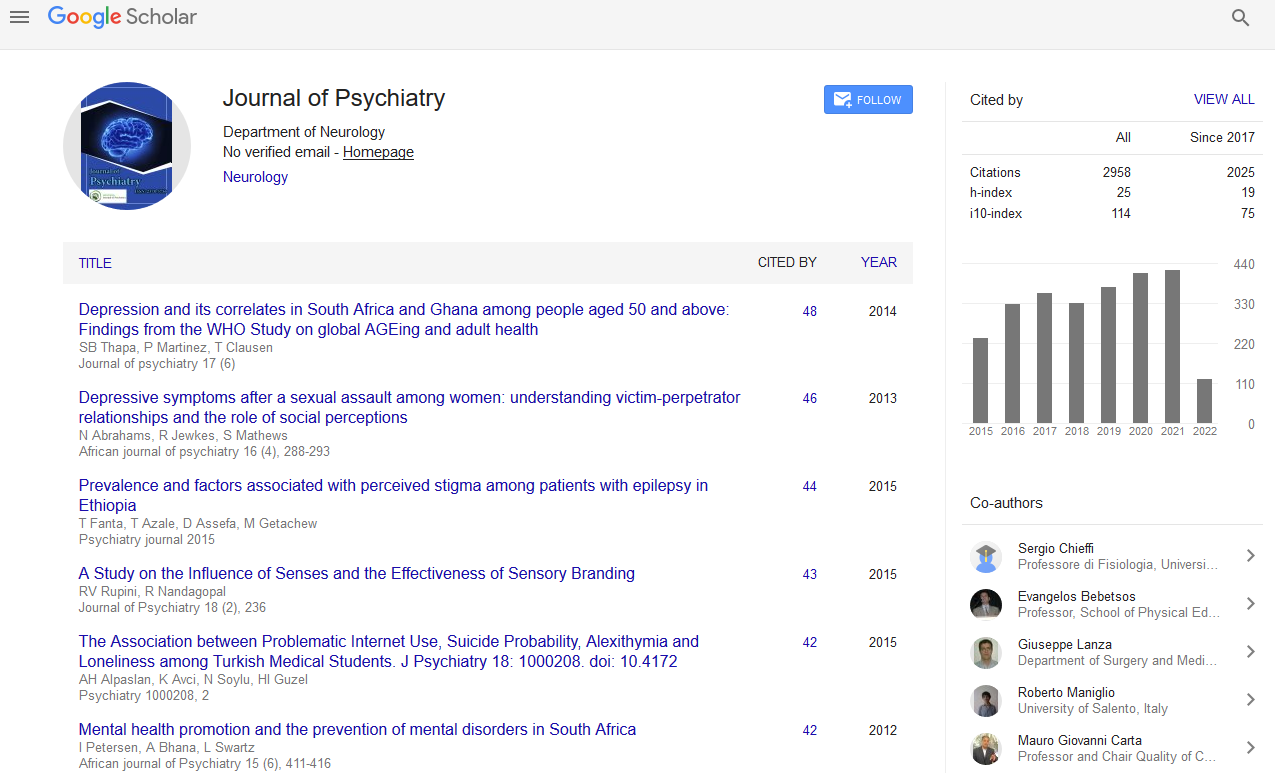PMC/PubMed Indexed Articles
Indexed In
- RefSeek
- Hamdard University
- EBSCO A-Z
- OCLC- WorldCat
- SWB online catalog
- Publons
- International committee of medical journals editors (ICMJE)
- Geneva Foundation for Medical Education and Research
Useful Links
Share This Page
Open Access Journals
- Agri and Aquaculture
- Biochemistry
- Bioinformatics & Systems Biology
- Business & Management
- Chemistry
- Clinical Sciences
- Engineering
- Food & Nutrition
- General Science
- Genetics & Molecular Biology
- Immunology & Microbiology
- Medical Sciences
- Neuroscience & Psychology
- Nursing & Health Care
- Pharmaceutical Sciences
At-risk mental state for psychosis in help-seeking young people: An investigation into underlying affective and interpersonal risk factors
2nd International Conference on Adolescent Medicine and Child Psychology
October 06-07, 2016 London, UK
Daniela Sofia de Freitas Semedo
University of Edinburgh, UK
Posters & Accepted Abstracts: J Psychiatry
Abstract:
Background: Considering recent advances in the field of early detection and intervention in young people with increased levels of psychotic symptoms seeking help, this thesis proposes that early attachment insecurity triggers an inability to regulate emotional distress, to engage in positive interpersonal interactions with others, to use adaptive coping mechanisms and to manage social support appropriately. These constructs appear to be linked to psychosis; however, considering continuity between sub-threshold psychotic symptoms and the later development of psychosis, it is vital to understand if these underlying affective and interpersonal mechanisms increase the risk of psychosis in help-seeking young people. Objectives: This study was cross-sectional and investigated the following research questions: 1) Does attachment insecurity signpost the risk of developing psychosis? 2) Do coping strategies, interpersonal difficulties, social support and emotional distress have an indirect effect on the relationship between attachment insecurity and the risk of developing psychosis? Methods: A total of 76 help-seeking young people were recruited from Community Mental Health Services in Edinburgh. All participants completed a number of questionnaires exploring their coping strategies, interpersonal problems, perceived social support and emotional distress. A semi-structured interview was undertaken, to assess their socio-demographic background. The Comprehensive Assessment of At-Risk Mental States was administered and coded to assess their risk of psychosis and associated psychopathology, while path analysis was used to analyse the data and to address the research questions. Results: Path analysis revealed that attachment insecurity directly predicted psychotic symptoms in the total sample (N=76) but not in the subgroup of young people with an ARMS (N=46). Emotional distress played a partially moderating role between attachment insecurity and the severity and distress associated with disorganised speech and perceptual abnormalities in the total sample but not when considering only those with an ARMS, while interpersonal problems did not mediate the relationship between attachment insecurity and the risk of psychosis in either group. Discrepancies between ideal and received social support fully mediated the relationship between attachment insecurity and the distress associated with disorganised speech in the total sample but not when considering those with an ARMS. The tendency to use less adaptive coping strategies was found to mediate directly the relationship between attachment anxiety and the distress associated with perceptual abnormalities in young people with ARMS, albeit not in the total sample. Discussion: The clinical and theoretical implications of these results are discussed within the clinical staging model for intervention in psychosis. The findings strongly indicate that clinicians should take into consideration the mechanisms of attachment, coping strategies and social support, as well as the deleterious effects of associated emotional distress, when working with young people with increased levels of psychotic symptoms.
Biography :
Email: daniela.semedo@gmail.com


